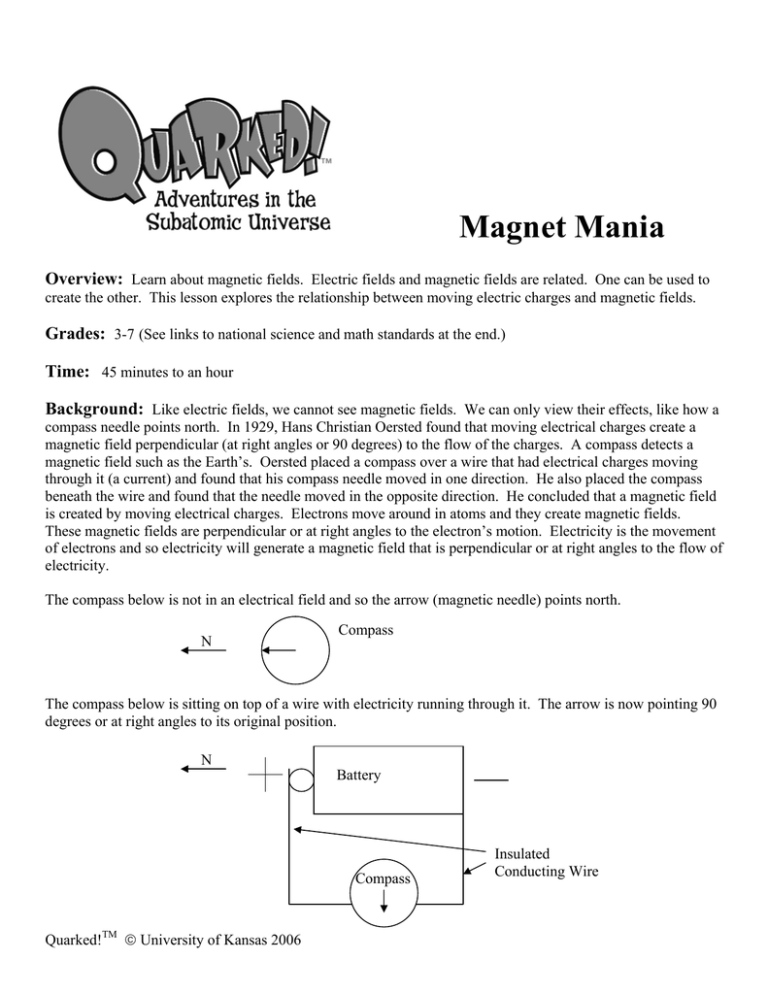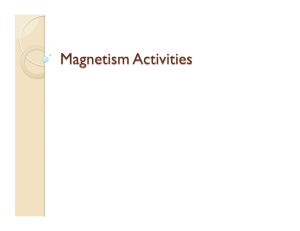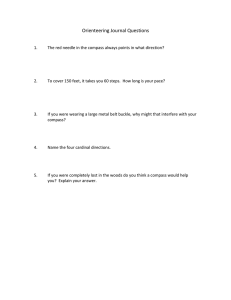advertisement

Magnet Mania Overview: Learn about magnetic fields. Electric fields and magnetic fields are related. One can be used to create the other. This lesson explores the relationship between moving electric charges and magnetic fields. Grades: 3-7 (See links to national science and math standards at the end.) Time: 45 minutes to an hour Background: Like electric fields, we cannot see magnetic fields. We can only view their effects, like how a compass needle points north. In 1929, Hans Christian Oersted found that moving electrical charges create a magnetic field perpendicular (at right angles or 90 degrees) to the flow of the charges. A compass detects a magnetic field such as the Earth’s. Oersted placed a compass over a wire that had electrical charges moving through it (a current) and found that his compass needle moved in one direction. He also placed the compass beneath the wire and found that the needle moved in the opposite direction. He concluded that a magnetic field is created by moving electrical charges. Electrons move around in atoms and they create magnetic fields. These magnetic fields are perpendicular or at right angles to the electron’s motion. Electricity is the movement of electrons and so electricity will generate a magnetic field that is perpendicular or at right angles to the flow of electricity. The compass below is not in an electrical field and so the arrow (magnetic needle) points north. N Compass The compass below is sitting on top of a wire with electricity running through it. The arrow is now pointing 90 degrees or at right angles to its original position. N Battery Compass Quarked!TM © University of Kansas 2006 Insulated Conducting Wire Moving magnets can also create an electric field perpendicular or at right angles to the motion of the magnet, and this is how generators work. Once the magnetic field stops moving (or changing), the electric field will disappear as well. Most things are not magnetic because for every electron that moves in one direction, there is usually another electron that moves in the opposite direction, so they cancel each other’s magnetic field out. A few elements (like iron and neodymium) have electrons that all move in the same direction, so they create a magnetic field. In other words, they are magnetic. Permanent magnets are made by aligning groups of atoms so that they move in the same direction. One way to create a permanent magnet is to melt iron which causes the atoms to move very quickly, and then place the iron in an external magnetic field - the electrons will align themselves so that they move in the same direction. The iron is then cooled, which slows down the motion of the iron atoms. The iron is cooled and the electrons remain in their new position and the iron is now magnetic. The Earth is magnetic and the magnetic poles have changed throughout time. What we call the North Pole is actually a south magnetic pole [the north pole of a magnet (compass) attracts to this pole and opposite poles attract. We call it the North Pole because the north pole of a magnet points towards it. Thousands of years ago, the poles were switched, with the north becoming south and vice versa. This has happened repeatedly through Earth’s history. In fact, there is a possibility that the poles will switch again in our lifetime. Geologists study the history of these switches by examining the iron in the Earth’s crust. Particle physics use large electric fields to accelerate particles to very high speed to break particles apart when they collide. These particles are very small—so small that physicists have a tough time getting them to hit each other. They can use magnetic fields to steer charged particles toward each other to make them collide. When particles do collide with enough energy (or speed) to break apart, they leave behind a particle soup (lots of smaller particles). Some of the particles are charged and some are not. Physicists know this because the collisions happen in a magnetic field. The charged particles will deflect or change direction in the magnetic field while non-charged particles will be unaffected. A negatively charged particle will travel in one direction, and a positively charged particle will travel in the opposite direction. Objective: Create a magnetic field using electricity and observe its effect on the magnetic needle on a compass. Materials: Each pair of students needs • 2 Batteries (try 1.5V or AA batteries) • 2 pieces of insulated conducting wire, each around 20 cm long (8 inches) with one cm of each end stripped of its insulating coat • Compass (found at any Radio Shack or outdoor equipment store) • Permanent magnets found at toy stores or scientific supply stores • Masking tape or electrical tape (to tape wires to terminals) Procedure: Caution: leaving the wire attached to the batteries will shorten the lifespans of the batteries and may make the wire hot (depending on the voltage of the battery). Quarked!TM © University of Kansas 2006 1. Place the compass on the table with the needle pointing magnetic north. Bring a permanent magnetic near the compass and observe what happens to the needle. Move the magnet around different sides of the compass and observe. 2. Place one battery on the table with the positive end oriented towards magnetic north (use your compass to figure this out). See diagram in background section. Tape one end of the wire to the positive end of the battery. Lay the compass on top of the wire so that the needle points magnetic north (in the same direction as the positive end of the battery). Touch the other end of the wire to the negative end of the battery and observe what happens to the needle on the compass. If necessary tape the wire down to the table to hold it into place. 3. Follow the setup in step 2, but this time move the compass away from the wire. First, move it up, and then start at the wire again and move it away from the battery and observe. 4. Repeat step 2, but this time place the compass under the wire and observe. 5. Leave the first setup where it is and now create a second mirror image circuit (see below). Make sure that batteries are facing opposite directions. Place the compass on top of both wires and connect the wires to the batteries (to complete the circuit) and observe the compass needle. electrons circuit A circuit B electrons Results and Discussion: 1. If the two north poles are brought together (the needle and permanent magnet), the magnetic needle will point in the opposite direction, or south. If the south pole of the permanent magnet is brought towards the needle, it continues to point magnetic north. Like poles repel and opposite poles attract so magnetic fields influence each other. 2. The compass needle moves towards the west, 90 degrees from where it was. If it is not exactly aligned to the west, it may be because the battery is weak or you are near another magnetic field such as a computer. Electricity moved the compass needle which means electricity generates magnetic fields. 3. When you move the compass away from the wire, the needle returns towards it original position (pointing towards magnetic north). This means the magnetic field becomes weaker the further you move from the wire. 4. The compass needle moves towards the east, 90 degrees from where it was and in the opposite direction to when the compass was on top of the wire. So the magnetic field direction is different above and below the wire. This happens because there is actually a magnetic field created which goes around the wire. 5. The compass needle continues to point magnetic north. As long as the batteries are identical (that is, one has not been used more than the other), the circuits will have the same number of electrons flowing in each direction – remember the batteries are oriented in opposite directions. This means that they will create equal but opposite magnetic fields that cancel each other out, so there will be no magnetic field produced. Quarked!TM © University of Kansas 2006 Follow up activities: a. Lesson plans What shape is it? and Invisible Investigations also explore how to find out about something you can’t see. b. Lesson plan Charge Challenge explores how different electrical charges interact. c. To learn more about particle physics and how detectors work, check out the www.fnal.gov site. NATIONAL STANDARDS This lesson plan addresses the following national standards in science and math: Science Standard A – Science as Inquiry Students should develop abilities necessary to do scientific inquiry and an understanding about scientific inquiry. Standard B-Physical Science Students should develop an understanding of the properties of objects and materials including electricity and magnetism as well as motions and forces of objects. Standard D – Earth and Space Science Students should develop an understanding of properties of earth materials Standard E – Science and Technology Students should develop an understanding about science and technology Standard G-History and Nature of Science Students should develop understanding of the nature of science. Math Data Analysis and Probability Standard - Formulate questions that can be addressed with data and collect, organize, and display relevant data to answer them - Design investigations to address a question and consider how data-collection methods affect the nature of the data set; - Collect data using observations, surveys, and experiments; Quarked!TM © University of Kansas 2006


